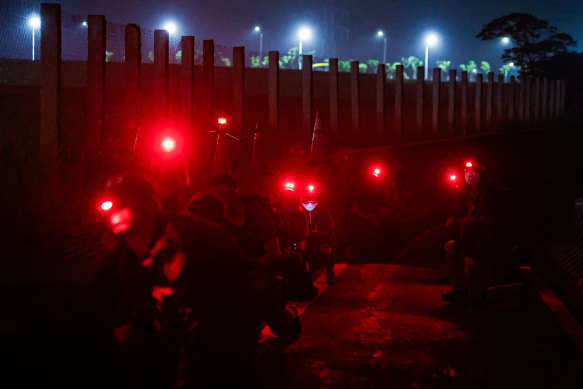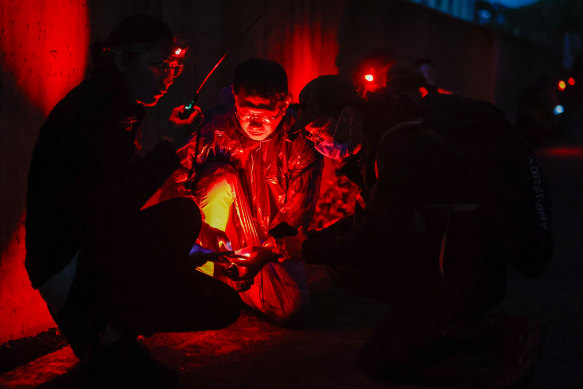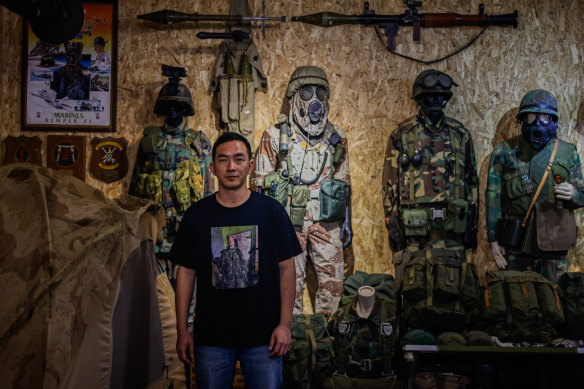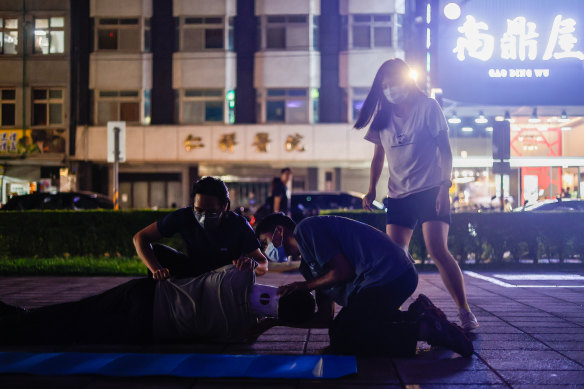
It is a Wednesday evening on the outskirts on Taipei and a group of 16 strangers is creeping along a woodland nature track, the lights of their headlamps a string of red eyes in the darkness.
They move in silence. Only a forest song of crickets and night birds cuts through the quiet. Suddenly, the group’s leader stops in his tracks and thrusts a closed fist into the air, signalling danger ahead. One-by-one, like dominoes, they fall back to a crouching position.
A call comes over their radio network: there is a suspected Chinese bomb on the path ahead, and other explosives and enemy soldiers could be nearby.
“We must change our route,” the leader radios. “Stay low and keep your distance from the person in front of you, let them take the shrapnel hit.”
This is a drill, of course.

Civil defence group members conduct night-time radio communication, formation and explosive identification exercises simulating attacks by Chinese soldiers, in New Taipei, Taiwan.Credit: Daniel Ceng
Chinese President Xi Jinping has not ordered the People’s Liberation Army to invade Taiwan, a move that would plunge the small island democracy of 24 million people and its inferior military force into a fight for survival. But for this group – a ragtag assortment of paramedics, marketing professionals, government workers, students, and doctors – the threat of war feels real enough they are compelled to prepare themselves.
More than a dozen similar self-defence groups have popped up across Taiwan over the past few years, in a grassroots civilian resistance of sorts as Xi and his top brass have become increasingly belligerent in their threats to “reunify” Taiwan with mainland China.
This particular session is run by volunteers who have attended larger courses organised by the Taiwan Militia Association, a not-for-profit organisation that encourages participants to take the knowledge back to their communities and set up their own local self-training groups.
Training millions
For two to three hours every week, often in a semi-isolated location, volunteers lead groups of like-minded strangers in practising survival skills in mock post-invasion scenarios – from applying first aid to pretend bullet wounds and bomb blast victims, temporary shelter construction, safe cybersecurity and data security practices, and off-grid radio training.
The TMA says it has trained about 600 people through its courses, of which 100 have either established or regularly attend 18-self-training groups across Taiwan.
Kuma Academy, another more high-profile civil defence outfit bankrolled by Taiwanese chip billionaire Robert Tsao, has set a goal of training 3 million people across Taiwan over a few years.
In the sprinkling rain, Christo Chen and his son, Kai, fiddle with their hand-held radio and iPhones. They are plugged into an off-grid network that allows users to share their location and send text messages – ideal for mimicking a situation where invading communist forces have cut off regular communication channels.
“I’m from an older generation, so probably I will already be dead,” Chen says about the prospect of war with China. Pointing at his 30-year-old son, he adds: “But that day will come and he may face it.”
At 64, Chen is one of the oldest participants at the training session, and though now retired, he has lived and worked in China for almost 30 years in a company auditing role. For a long time, he bought into the Chinese Communist Party’s vision of a greater China that encompassed Taiwan – and saw himself as part of this Chinese identity.

Christo Chen, 64 (centre) and his son Kai, 30, (left) practise using off-grid radio transmitters as part of a civil defence training course in New Taipei.Credit: Daniel Ceng
But this gradually eroded, he says, as he watched the relative freedoms of the 1980s, when China began opening to the world under Deng Xiaoping’s leadership, give way to Xi’s unflinching grip on power.
“Before, China was not a place where everything was decided by one person. Now Xi Jinping has the call on all things,” Chen says.
“I’ve gone through a lot in China, experiencing the kind of corrupt system they have there. It makes me feel that I need to protect the system that we have built here over the years in Taiwan.”
Threat of annexation
For decades, Taiwan’s civilians – more than 60 per cent of whom now identify as solely Taiwanese as many people’s affinity with a Chinese identity has declined – have lived in the shadow of their neighbour’s long-professed objective of “peaceful reunification”. It is a goal anchored in the CCP’s view that the island is part of China’s territory despite having never governed it.
But under Xi, this ambition has become an increasingly stark threat of annexation. He has overseen a massive, rapid strengthening of the People’s Liberation Army’s firepower which, according to US intelligence, aligns with his directive for it to be capable of invading Taiwan by 2027.
Alongside this militarisation, Beijing has ramped up its grey zone warfare – tactics that fall below the threshold of outright war – including flying PLA fighter jets in Taiwanese airspace in a near-daily campaign of harassment. Last month, the PLA carried out two days of military drills encircling Taiwan involving the army, navy, air force and rocket force in mock invasion exercises.
However, Xi has never given a deadline by which Taiwan should be seized by the mainland. Separately, China watchers in the West regularly debate reasons as to why Beijing will not launch an attack any time soon. These include Taiwan’s extreme geography as a rocky and mountainous island that would make an invasion very difficult; the likelihood of a protracted and costly conflict, particularly if the US and her allies come to Taiwan’s defence; China’s faltering economy; and the ostracism it would face on the international stage including through economic sanctions.
For many Taiwanese citizens, Russia’s invasion of Ukraine in February 2022 was a complacency-shattering event. It drove home the reality that a hot war at the hands of an invading authoritarian neighbour was possible in the 21st century.

Tony Lu, who fought in Ukraine alongside Australian Trevor Kjeldal, wears a T-shirt depicting his friend, who died in battle.Credit: Daniel Ceng
Tony Lu, 35, was working as a butcher in Taoyuan, north-west of Taipei, when Russian troops crossed the border into Ukraine and launched missile strikes on Kyiv and a dozen other cities in the opening days of its surprise attack. Within weeks, Lu had booked a plane ticket to the besieged country, telling no one of his plans, and left for the war zone before giving his family a chance to change his mind. He stayed for three months and was deployed to the deadly front lines around Kharkiv and Izium, in the country’s east.
“What was going through my mind was, ‘we have to do our part to help Ukraine’,” Lu says.
“Maybe in the future when we are in a similar situation, then we can get help from Ukraine or other countries.”
Softly spoken, clean-shaven and a self-described “citizen of the world”, Lu cuts a slightly incongruous figure as he perches on a stool at the Taiwan Airsoft and Airgun Association in New Taipei, surrounded by replica firearms, combat equipment and US military war propaganda posters.
Loading
He is wearing a black T-shirt screen-printed with the image of Australian man Trevor “Ninja” Kjeldal, a Queenslander with whom he struck up a close friendship in Ukraine while fighting together as part of a foreign battalion. Kjeldal, 40, was killed in battle in the Luhansk region in November 2022, months after Lu left Ukraine.
These days Lu has a part-time role at the airgun organisation speaking to school and university-aged students about his experience in Ukraine, which he says underscored to him the importance of civilian resistance after he watched locals pick up arms against the Russian forces.
“It’s a 50-50 situation whether Taiwanese people will do the same thing as Ukrainian people,” he says. “You don’t know until you are tested, but when a rocket lands in front of your house, that’s when you decide to pick up and fight.”
‘We can prepare and resist’
Academic and activist Wen Liu, who studies the psychology of war preparedness in Taiwan, says the emergence of civil defence groups run by the NGO sector, rather than government, is a response to the fact that war planning is a highly politicised issue within the country.
The two major political parties are divided in their approach to managing the China relationship, with the ruling Democratic Progressive Party (DPP) regularly accusing its rival, the Kuomintang (KMT) of being too sympathetic to Beijing. Conversely, the KMT accuses the DPP of being too aggressive in confronting China, putting the country on a path to war.
“That’s why it’s so important for a civil organisation to do this work. A lot of these skills that can be used not just during wartime, but also in any kind of disaster relief. That is a more neutral way people can communicate the importance of preparedness across political spectrum,” says Liu, who is affiliated with Kuma Academy.

Sue Chang (right) and her civil defence group practise first aid skills on the footpath in Taoyuan, Taiwan.Credit: Daniel Ceng
There is no doubt, however, that the civil defence movement attracts an activist pro-independence crowd, putting them at odds with the broader population, most of whom do not support Taiwan pursuing formal independence, one of China’s red lines that would likely trigger war.
On a footpath outside the Taoyuan Chinese Orchestra concert hall on a Tuesday evening in late May, 35-year-old government worker Sue Chang is leading a small group of five people in practising first aid skills under the dim glow of a nearby hotpot restaurant.
They take turns applying a neck brace to each other, and rehearse the steps for checking for spinal injuries and internal bleeding, assiduously ignoring the stares of passersby taking their dogs for a night walk. The informality of the surroundings lends an almost amusing air to the process, but Sue and her participants are dead serious.
“There is no room to even think about this outcome,” she says about the prospect of Taiwan falling under CCP control. “I would probably be killed immediately. I recognise myself as a Taiwanese person, and I work as a civil servant. It’s likely these two things would put me in a very dangerous situation.”
Another participant, Andy Tsai, 37, says being a visible presence on the street is critical to counter a common community perception that Taiwan doesn’t stand a chance in the face of China’s war machine.
“What is most concerning domestically is a situation where people do not have that political will to fight back against a Chinese invasion. We also want to show our people that we can prepare and we can resist,” he says.
Get a note directly from our foreign correspondents on what’s making headlines around the world. Sign up for the weekly What in the World newsletter here.









 Add Category
Add Category